HEALTH BENEFITS
 |
 |
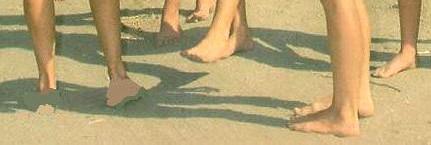 |
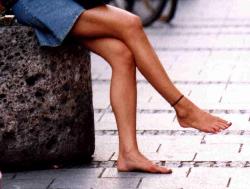 |
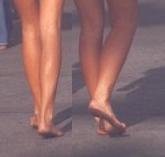 |
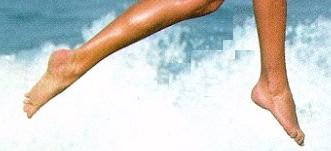 |
|
• "Why Walk Barefoot?" • Part 2: Getting Started: How Long To Toughen the Soles? |
• Plantar Fasciitis & Barefooting • Part 3: What People Say • Barefoot links |
|
HEALTH BENEFITS
|
"Why Walk Barefoot?"

|
The body needs a little harsh treatment to keep it healthy. Exercise seems uncomfortable at first, but no one would call it "abnormal." Living things develop strength only when they are subjected to pressure and resistance. For the feet, this means finding a piece of land with varied surfaces and walking on it without the artificial barrier of footwear separating you from the earth.

|
|
|

|
If an inattentive patient steps on something and cuts their foot, the Doc might be sued if he didn't advise them to constantly wear shoes. But if an eternally-shod patient develops gangrene and requires amputation, the Doc can blame it on a pre-existing disease! So this is something that we have to take personal responsibility for. It's simple common sense: The barefoot-walking that we were naturally designed for stimulates the blood-flow and improves the foot's condition. We will just have to shoulder the responsibility of watching out for injuries!
Obviously we can't give up shoes altogether in our present world. Illogical social assumptions arise from one's eschewing of footwear. But you could work-in 30 minutes of walking across a varied terrain of rocks, gravel and grassy surfaces each day.
What about the neophyte who has never done any serious barefooting? The soles have to be gradually toughened by routine exposure to a variety of surfaces. One method is to wear massage "slides" like Adissage (or a generic equivalent)- these have plastic nubs on the sole that resemble walking on a stimulating surface. (See "Part 2" below). After some time walking in these, your soles will be ready to step it up a notch and walk on a piece of terra firma.
There are also a lot of myths that scare people away from barefooting, suggesting that it is unhealthy, inappropriate, or even illegal. It takes time to get used to any change in routine, and barefooting is no different. You'll have to respect your natural design enough to do what nature demands of it. Other people's opinions won't keep you healthy!
| - Ray Jefferson |
| |
Shoes cause the muscle in the arch to become weak. Going barefoot strengthens it.
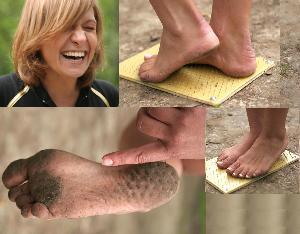 |
Photo: http://forum.city-feet.com/index.php/showforum.5 |
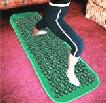 |
| |
For a rank tenderfoot, 3 or 4 weeks of barefooting on incrementally roughened surfaces, for 30 minutes or so, 3 or 4 days a week, will condition the soles for daily periods of b/f walking. As for "roughened surfaces," start with grass until accustomed to the sensation of your skin against the ground. Move on to sand, smooth stones (like at the beach), then gravel. Then try some treks through country pathways or places with a variety of undulations: tree roots, sticks, stones & pebbles, etc. Avoid areas visited by dog owners or otherwise marked by animal waste.One way of conditioning your feet for barefooting is to use "massage sandals" which have protruding nubs in the sole which press into the sole of your foot. Adidas has pricey ones which, users say, don't last long. Discount department stores (e.g., Walmart) have better ones at lower cost. You can also remove the nubbed sole and use them as inserts in your shoes to produce the same conditioning while you walk in "civilized" footwear.
1 Footnote: If this is the first time the sole has experienced this amount of contact, one of the after effects may include a mild fatigue. This corresponds to the theory that the nerves of the foot affect other areas of the body. The sole has been effectively "asleep" for all these years while encased in shoes, and this sudden barrage of stimulation (actually the normal stimulation that it's been heretofore deprived of) has overloaded your body with these healthy signals. It's similar to having been deprived of a vitamin and then experiencing a "rush" when finally given a healthy dose of the nutrient.
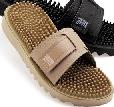 |
Remember to walk "natural," as mentioned above. This is wholly different than the way we're used to walking in shoes. Avoid "heel-first" walking. Land on the ball of the foot, and roll back toward the heel. The "feel" provided by bare contact with the earth will incline you to walk in the natural way fairly automatically. Other points of barefoot posture are to lean forward from your ankles, maintain a slight bend of your knees for a more "fluid" motion, hips under the body (trunk), torso vertical. First-time barefooters usually have a problem with sensitivity. The signals from the contact are strange to us and we need to process them as clues as to how to position ourselves. Then we need to harmonize those clues with the signals our body is giving us. Like anything new, this takes time, but it's important to bear in mind that this "strangeness" is actually what we were designed to do naturally. We're just re-acquainting ourselves with this inborn trait.Your soles will "toughen," but you won't see thick calluses as the skin does not harden as such. That condition is actually the result of abrasions caused by shoes, not from barefooting.
Other comments on this subject - www.runningbarefoot.org/?name=HowRunBarefootOtherwise2001July29Saxton
FASCIITIS PLANTAR
& Flat Feet

With every step, our feet need to do two opposite things:
The flexible part is called PRONATION. It adapts to clumps of grass, little pot holes and other variations in the ground surface. If the foot remains pronated as we push off, the plantar is too limber. It's like trying to run on wet sand.
- First when they land on the ground they need to get flexible so they can adapt to the varying ground surfaces.
- Then they need to get rigid so the can propel us forward with strength.
FLAT FEET. When your feet pronate they take the whole leg with them. The misalignment of ankle, knee and hip joints can result in pain and injury. An orthotic device - to raise the arch - usually remedies the condition.
Plantar Fasciitis is an inflammation caused by excessive stretching of the plantar fascia, the band of tissue which runs along the bottom of the foot, attaching the heel bone to the forefoot (the "arch" area). When excessively stretched, this can cause plantar fasciitis, leading to heel pain, arch pain, and heel spurs.
Pronated means that the foot tends to roll inwards when a person walks or runs. Pronation occurs when the arch of the foot is collapsed or lowered. Flat feet are the leading cause of plantar fasciitis. Over-pronation occurs in the walking process, when a person's arch collapses upon weight bearing, causing the plantar fascia to be stretched away from the heel bone.
THERAPEUTIC BAREFOOTING
So where does "barefooting" come in to this picture? Clearly you can't start from having plantar fasciitis or flat feet to being a full-time barefooter. But if barefoot walking is used as a therapy to strengthen the feet, you can keep aware of your foot's needs as you carry out your barefoot sessions. Though orthotic arch supports help while you are wearing shoes, THEY DON'T STRENGTHEN THE ARCH! Barefoot walking enables just that.Starting gradually, you can restore the natural action of the arch and strengthen it. It may not become perfect, but it is certainly healthier. For one thing, you are stimulating the blood flow in an area of the body that is usually neglected: the smallest blood vessels in the body are in the feet. And of course any increase in the strength of your arch is welcome, improving gait, posture, and feeling of overall strength.
reference: www.runningbarefoot.org/?name=PlantarFasciitis
 |
Those with plantar fasciitis usually wear shoes most of the time. The inflexible sole in shoes prevents the plantar tendons from flexing and bending naturally and leaves them weak. People with shoes learn to land heel first, aggravating the achilles tendons. Note that the raised heels on shoes shorten the tendons, and make them more susceptible to injury. Pressure on the heels also seems to aggravate/cause plantar faciitis. All of these factors can irritate our plantar tendons. Yet the shod, in their pain, complain about barefooters and ask us to wear their unhealthy footwear.As with most foot problems in shoe-wearing society, Plantar Fasciitis is more common among women, likely due to the fact that women wear the most restrictive and deforming footwear.
Plantar fasciitis is most painful when the foot has been inactive for a while, like in the morning after a long sleep. So it should be no surprise that the best treatments are those that build foot flexibility and strength -- not just "orthordics" that conform the foot to the shoe. Going barefoot improves both flexibility and strength, whereas shoes limit both flexibility and strength. Most surveys of which treatments work best probably do not include going barefoot. In fact, many patients are told NEVER to go barefoot, the one treatment that might actually solve this problem.
Tension is at the root of many of our pains. Therefore, learning to relax and allow the foot to bend naturally is probably the most important treatment for plantar fasciitis and other pains. Shoes do not allow the foot to relax and bend naturally. If the foot tries to relax, and flex naturally, it runs into a wall: the inside of your shoe.
Before getting out of bed, relax and stretch. As teenagers it took ten minutes to get out of bed because we alternated between stretching and relaxing. It is natural, but we forget this as adults feeling rushed to jump out of bed and guzzle some caffeine to get to work on time.
Get your feet used to being flexed and used. One thing we can do when "sentenced" to long hours at computers, watching TV, etc., wiggle the toes slowly and gently, preferably barefoot.
Roll your bare soles over a tennis ball, softball, or other ball for massage.
Some people have to stand or walk for long periods of time on hard floors or ground, usually in restrictive shoes. Don't just stand there! Get some exercise. Try getting into the runner's pose: keep your torso vertical, bend your knees, and lean your hips slightly forward, just enough so your weight begins to come off your heels. (HINT: this will be a lot easier, if your shoes don't have a raised heel) If you lean a little more, you'll have to run to keep balanced. But we just want to be near that "runner's lean". Don't hold this pose static, though: try rocking occassionally, shifting your weigh back and forth, side to side, foot to foot.
 |
One major problem which has resulted in a near epidemic of P.F. is that we simply do not walk barefoot for long enough periods. Instead of several hours of easy gentle exercise, we compress it into short but intense periods of exercise. Our bodies, however, are designed for long periods of easy, gentle exercise, like walking.When we do walk, we are often wearing heavy restrictive shoes that do not allow the feet to flex and work naturally. So if you must wear shoes to work, wear shoes that you can easily remove to exercise your feet whenever possible.
For treating P.F., soft uneven surfaces help flex the tendons & muscles of the foot in a natural pattern. Grass, or soft sand provide a good varied workout for the feet, ankles, achilles, and plantar fasciia. WALK barefoot, naturally, whenever possible and practical.
Remember, as with any change in routine, start short, slow, and build gradually.
-----------------------------
Arch supports are NOT going to make your arches stronger. That's like trying to strengthen your ankles by putting your ankle in a cast!
Hookworm
Hookworm has been a problem in impoverished areas of rural america in the past and other parts of the world. Since this was contracted by going barefoot on terrain that had been contaminated by animal or human waste, it is important to avoid areas where this would be a problem.
In 1908, a Dr. Charles Wardell Stiles addressed the problem of hookworm in the rural U.S., delineating the cure as thymol, which pried the hookworms from the digestive tract, and epsom salts, which flushed them from the body. One source specifies:
Specific information is difficult to locate. But the point is that it is treatable. It also is largely avoidable, even for barefooters, as long as you keep an eye on the terrain.
- EPSOM SALTS: Used to purge the system the night previous to taking thymol.
- THYMOL: 1 to 3 grams every two hours.
"The patient, following the epsom salt purge, stays on a liquid fast until 1pm the following day. He then is given Thymol in doses not exceeding 4 grams. Another epsom purge is given that evening, and the thymol administered again the following day..."
- from "Southern Practitioner. Google book
• Google search results
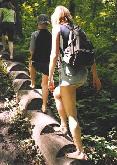
Barefoot Parks

As people have come to recognize the health benefits of barefoot recreation, parks have sprouted up which accommodate this therapeutic activity. Barefoot parks feature paths with specially roughened surfaces that stimulate the soles (the natural mobilizer of circulation in the feet). Each park has its particular features, such as wooded areas, walking across stream beds, and conditioning areas with sticks, stones, pebbles and other indulating components to bring newly unshod feet up to speed and strengthen them. Some barefoot parks are listed in the "Links" section at the bottom of this page.But these parks are also good sources of ideas for creating your own b/f recreation. The beach is an obvious one, with such surface variants as smooth stones and jagged rock. You can create sole-toughening areas in your yard or even indoors using varieties of sand, stone/rock, and wood.

I think I dropped the keys somewhere around here...

Yoga Question
Q: Why do I have to be barefoot when practicing yoga?A: Being barefoot is required for two reasons:
- You are a lot less likely to slip on your mat and hurt yourself.
- There are thousands of nerve endings in your feet that feedback information to your body and will help into the postures correctly and fully experience the postures. Give those poor hardworking feet some air!
P A R T T H R E E:
What People Say:
"Did You Know..."
In clasical antiquity, shoes were the mark of a free man: slaves went barefoot. Shoes are the sign that the individual is his or her own master, self sufficient and responsible for his or her actions. - "Dictionary of Symbols," Alain Gheerbrant
-----------
Cars and offices are surrounded by electrical fields that mess up the polarity of the human body. Walking on damp grass is thought to short-circuit that and reset your body?s polarity. Makes sense, right?...
-----------
"Shoes act like casts, holding the bones of the foot so rigid that they can't move fluidly. The foot becomes passive from wearing shoes and loses the ability to support itself." - Steven Robbins [MD and adjunct associate professor of mechanical engineering at Concordia University, Montreal]